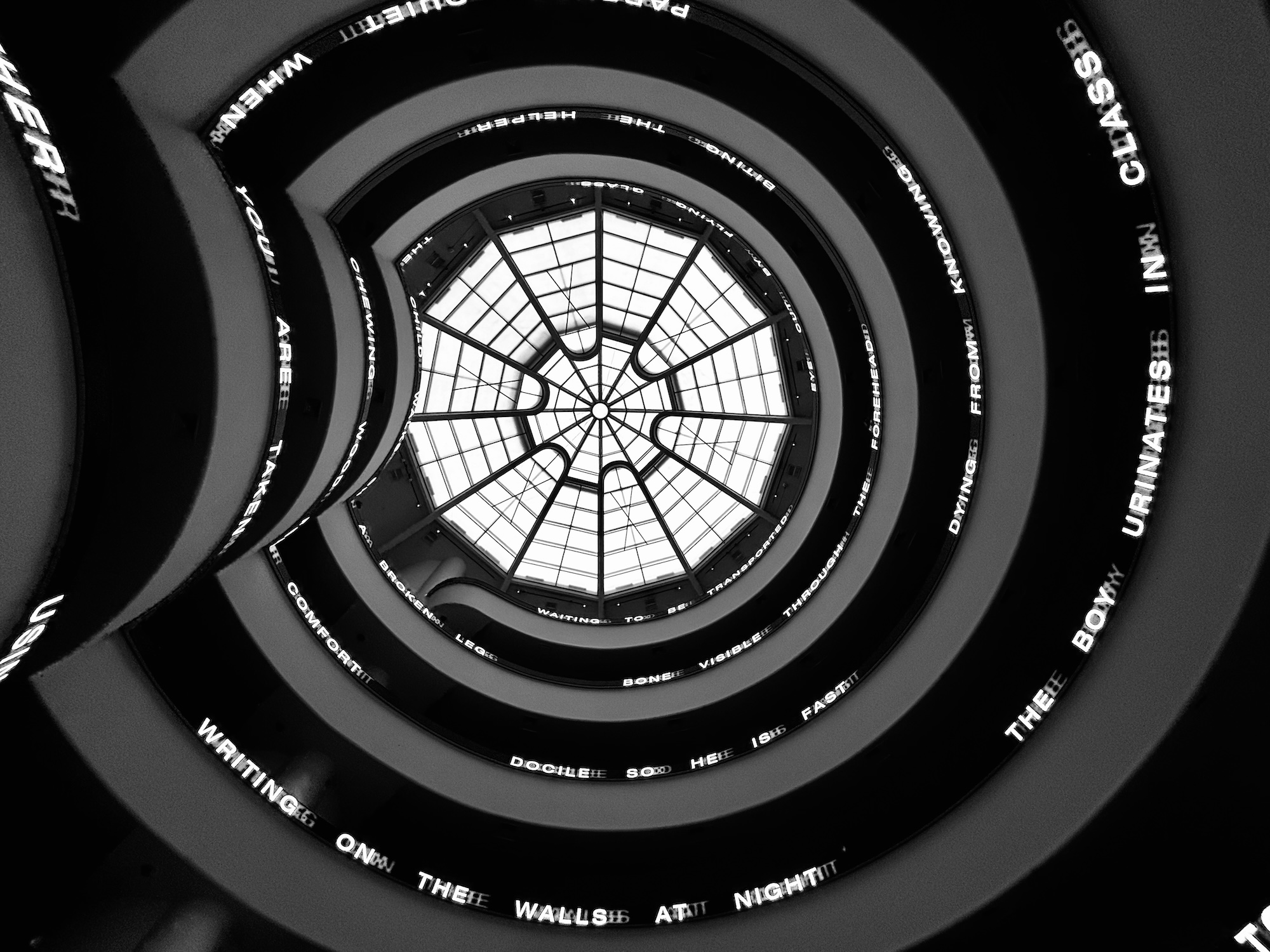
I saw the Jenny Holzer show at The Guggenheim this week; close friends will know that I have a strange relationship with her work. The exhibition, which closes next week, is sort of a reprise of her groundbreaking show there in 1989. Here’s Roberta Smith’s review in the Times from December of that year (emphasis mine):
Ms. Holzer has been given the run of the Guggenheim, or more precisely half of it, and she has come up with a trio of installations that nearly strips the building of art yet fills it in her own way. She has focused her activities almost entirely on the Guggenheim’s great tiered atrium, leaving the walls of its coiled ramp bare. The museum has never looked, nor felt, quite like this.
In effect, the building has been turned into a vast darkened cave with glowing embers at its center: a 535-foot-long moving message that snakes its way around the first three tiers of the museum’s coil, offering a retrospective of Ms. Holzer’s writing as it goes.
This mixing of Ms. Holzer’s different texts emphasizes the range of her writing and the different voices she has called into service. She can offer wise words to live by, put you in touch with your most private memories or make you fear for the future of the planet.
In addition to the meaning of her words, there is the perceptual power and wonderful spatial disorientation of their upward-circling stream, which are heightened by shifts in color, typeface, speed and, upon occasion, direction. Standing on the ramp with the words moving above and below, the viewer feels like a small blip in some giant video game. As one moves down the ramp, the words circle at about the same pace - an effect that proposes each viewer as the center of a slowly revolving universe.
Fast forward to 2024, and the Guggenheim appears to have made some upgrades. Here’s Sarp Karem Yavuz in The Art Newspaper:
While the museum statement heralds Installation for the Solomon R. Guggenheim Museum as a significant archival project that involved reverse-engineering the LED screens used in 1989, the entire activity seems to eschew any practical consideration in favour of laborious reverence… or perhaps a kind of insistence on authenticity. Like a VHS-tape filter on a TikTok video, despite mimicking the form of the older installation, the new and improved LED screens feel lacklustre in their nostalgia. In 1989, using inherently commercial LED-screen technology to reimagine the Guggenheim’s exhibition capabilities was refreshing and innovative. This time around, the hardware is neither vintage enough to be quaint nor cutting-edge enough to be a commentary on technology or capitalism today.
Back to Smith in 1989:
While the moving-message piece is the exhibition’s main event, it is balanced by two installations using carved benches that provide a needed sense of stillness. On the ground floor of the atrium is a large circle formed by 17 red granite benches that suggests an ancient campfire or a church meeting. In the two-story gallery at the beginning of the ramp’s first tier, 27 white granite benches are placed in closely regimented formation like markers in a crowded cemetery. Carved with phrases that also appear in the moving-message sign, these bench works, as they might be called, point to the ancient communal rituals of storytelling and mourning that inspire much of Ms. Holzer’s work.
I wish the museum curators had reprised not only the snaking text work up the museum’s coil, but also what appears to be remarkably daring restraint with the rest of the 1989 show. I loved this year’s main event, but the walk up the ramp was forgettable. I don’t think Lee Quiñones added much of interest to the wall full of Inflammatory Essays; the Trump Tweet pieces were painfully obvious; the redaction paintings didn’t work in the odd Guggenheim galleries. Honestly if you’re in New York, you should step into the museum lobby, admire the snaking Light Line, snap a few pics for the ‘gram, and head to the Met.
I’ll never stop loving her work, though. For me, Holzer is all about the truisms. Here’s what New Yorker critic Jackson Arn had to say in his review from this year.
“Truisms,” a cycle of almost-aphorisms that Holzer began scattering across New York in the late seventies, has no signature color or typeface or look of any kind, with the upshot that it can thrive anywhere—walls in SoHo, T-shirts, Spectacolor signs in Times Square, a Vegas marquee, a Qatar airport. The words speak with the authority of whichever billboard they’ve crashed, only to squander it on advice that is either too obvious or too obscure to help us. What they reveal is not capitalism’s secret messaging so much as an absence of all messages, nothing but surfaces desperate for eyeballs.
I’d tell you to follow @jennyholzer on Twitter, but talk about surfaces desperate for eyeballs…